 Website:
RENISHAW
Website:
RENISHAW
Catalog excerpts

XK10 alignment laser system
Open the catalog to page 1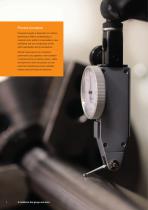
Process foundation Component quality is dependent on machine performance. Without understanding a machine’s error profile it is impossible to have confidence that your components will fall within specification during manufacture. Periodic measurement of a machine’s performance and capability is the foundation of process control, providing a known, stable environment in which the process is to be performed. Quantifying process capability reduces costs and improves efficiency. A traditional dial gauge and arbo
Open the catalog to page 2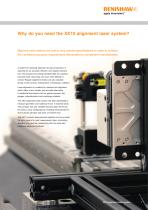
Why do you need the XK10 alignment laser system? Machine tools need to be built to very precise specifications in order to achieve the increasing accuracy requirements demanded by component manufacturers. A system for checking alignment during construction is essential for an accurate, efficient, and reliable machine tool. This avoids errors being identified after the machine has been built, when they are much more difficult to correct. Regular alignment checks are also valuable during on-site service, maintenance or following a collision. Laser alignment is a method for machine tool...
Open the catalog to page 3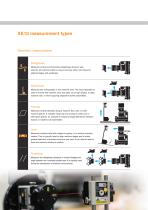
Geometric measurements Straightness Measures vertical and horizontal straightness along an axis. Used for all machine builds to ensure accuracy when mounting and aligning stages and guideways. Squareness Measures the orthogonality of two machine axes. This would typically be used to ensure that machine arms and beds are at right angles, to align machine rails, or when squaring separate machine assemblies. Flatness Measures vertical deviation along a machine bed, rails, or other machine planes. A versatile mode that can measure continuous or interrupted planes, for example to measure height...
Open the catalog to page 4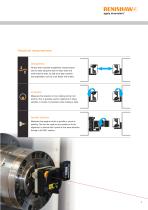
Rotational measurements Straightness Vertical and horizontal straightness measurements can be made along the axes of rotary tools and small machine tools, as well as to align machine sub-assemblies, such as a bar feeder with a lathe. Coaxiality Measures the deviation of one rotating centre from another. This is typically used for alignment of rotary spindles or chucks, for example when building a lathe. Spindle direction Measures the angle at which a spindle or chuck is pointing. This can be used for any spindle or chuck alignment, to ensure that it points in the same direction through a...
Open the catalog to page 5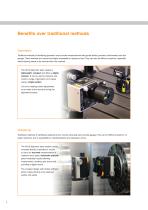
Benefits over traditional methods Geometric Traditional methods of identifying geometric errors involve measurements with granite blocks, precision inclinometers and dial gauges. These methods are manual and highly susceptible to operator errors. They can also be difficult to perform, especially where fixturing needs to be removed from the machine. The XK10 alignment laser system is lightweight, compact and offers a digital solution. It can be used to measure and record a range of geometric error types using a single system. Live error readings allow adjustments to be made to the machine...
Open the catalog to page 6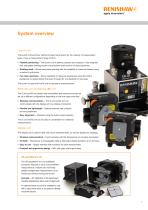
System overview Launch unit The launch is the primary method of laser transmission for the majority of measurement types. It has a measurement range of 30 m. • Flexible positioning – The launch unit is battery powered and compact. It has magnetic feet, adjustable levelling screws and precision levels built-in for easy placement. • Rotating head – Allows easy beam pointing with the capability to measure flatness using a series of grid points. • Two laser apertures – Allows capability to measure squareness using the built-in pentaprism to quickly switch the beam through 90° and flexibility of...
Open the catalog to page 7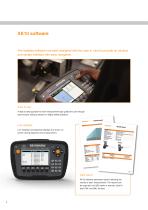
Pre-installed software has been designed with the user in mind to provide an intuitive and simple interface with easy navigation. Easy to use A step by step approach for each measurement type guides the user through each process reducing reliance on highly skilled operators. Live readings Live readings and graphical displays are shown on screen during alignment and measurement. Data export XK10 software generates reports detailing the results of each measurement. The reports can be exported via USB (cable or memory stick) in both PDF and XML formats.
Open the catalog to page 8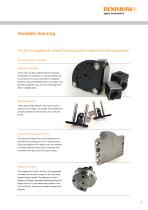
Versatile fixturing The XK10 is supplied with versatile fixturing suitable for different machine configurations. The XK10 system includes: Magnetic mounting The launch unit has magnetic feet for mounting horizontally or vertically to a machine surface, the S unit and M unit can be mounted on magnetic bases for improved flexibility. Each kit contains one standard magnetic base, and one mounting block with a rotatable head. Spindle adaptors These allow simple fitment of the launch unit or receivers into a lathe or a spindle. The standard kit contains adaptors for the launch unit, S unit and M...
Open the catalog to page 9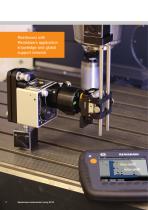
Reinforced with Renishaw’s application knowledge and global support network Squareness measurement using XK10
Open the catalog to page 10
Our ongoing commitment to service and quality provides our customers with the complete solution Training Renishaw offers an established range of comprehensive operator training courses either on-site or at a Renishaw training centre. Our experience in metrology allows us to teach not just about our products, but also underlying scientific principles and methods of best practice. This enables our customers to get the most out of their manufacturing processes. Support Our products enhance quality and productivity, and we strive for total customer satisfaction through superior customer service...
Open the catalog to page 11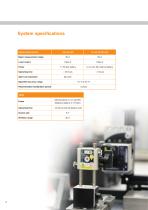
System specifications System performance Beam measurement range Laser output Power Operating time Spirit vial resolution Launch unit Specified accuracy range Recommended recalibration period Tablet Power Operating time Internal battery: Li Ion (43 Wh) Additional battery: 4 x R14(C) ~ 30 hours (internal battery only) Screen size Wireless range
Open the catalog to page 12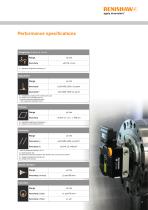
Performance specifications Straightness (Launch & M unit) Range Accuracy A = displayed straightness reading (µm) Squareness Range A = straightness reading of the furthest point (µm) M = length of the (shortest) axis (m) * without squareness calibration factor ** with squareness calibration factor Flatness Range Accuracy A = displayed straightness reading (µm) M = distance to the furthest point (m) Parallelism Range * laser to pentaprism distance >0.3 m (i) angle between rails (ii) geometric tolerancing relative to the reference rail / point to point variation A = (largest) straightness...
Open the catalog to page 13All RENISHAW catalogs and technical brochures
-
Metrology fixture table
4 Pages
-
Brochure: OMP60
6 Pages
-
OLP40 flyer
6 Pages
-
RFP1 fringe probe for REVO-2
2 Pages
-
RVP vision probe for REVO-2
2 Pages
-
MH20 articulating probe head
2 Pages
-
Data sheet: MH20 and MH20i
4 Pages
-
RTP20
2 Pages
-
PH10M-iQ PLUS
2 Pages
-
REVO-2 and RSP2 probes
2 Pages
-
SFP2 surface finish probe
2 Pages
-
Data sheet: HS20 laser head
2 Pages
-
Data sheet: RLU20 laser unit
2 Pages
-
Data sheet: RLU10 laser unit
2 Pages
-
RLMD01_09
13 Pages
-
RLBD01_04
9 Pages
-
RLCD03_03
9 Pages
-
HiLin™
20 Pages
-
PRIMO™ system
8 Pages
-
TP7M probe and stylus kit
5 Pages
-
RSP3-6 extended reach probe
4 Pages
-
RGH25F UHV, RGH20F UHV
8 Pages
-
RGH22 series readhead
4 Pages
-
Renishaw retrofit
12 Pages
-
Renishaw fixtures
8 Pages
-
SP80
4 Pages
-
SP600
4 Pages
-
Equator the versatile gauge
4 Pages
-
Styli for Zeiss applications
57 Pages
-
Precision styli
60 Pages
-
CMM technology guide
28 Pages
















































































